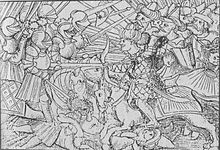Kapıkulu
Under Kapıkulu ( Ottoman قپوقولو اوجاغی Kapıkulu Ocağı ) means a unit of the army of the Ottoman Empire .
structure
This troop was composed of the infantry of the Janissaries , the court cavalry, the artillery ( Topçu ), the armourers (Cebecilers) and the Müteferrikas ( Hofouriers ).
The court cavalry was first set up in the 14th century and was recruited from the janissaries and the pages of the court.
This cavalry force was divided into six squadrons :
- Sipâh (the "riders") on the right wing
- Silâhdar (the "weapon bearers") on the left wing
- Sağ ulûfeliler (the "wages on the right")
- Sol ulûfeliler (the "paid workers on the left")
- Sağ garibler (the "strangers on the right")
- Sol garibler (the "strangers on the left")
The first two squadrons in the field were the bodyguards of the sultan or the grand vizier.
The Müteferrikas, the courtiers in the immediate entourage of the Sultan, were recruited from the sons of high dignitaries. In the field they were responsible for guarding the flags and horse tails.
The Kapıkulu troops the service was responsible for the Sublime Porte to the seat of government of the Sultan not only in the capital but also in the field, when the Sultan - as usual for a long time - led the campaign in person. The Kapıkulu were the center of the battle, the sultan's redoubt. Under Suleyman the Magnificent (1520–1566), however, the rule on the use of the Kapıkulu was broken only under the direct command of the ruler and their units took part in the fighting on the Hungarian theater of war even in the absence of the Sultan.
The Sultan's Lair
The element of the Ottoman battle order that was often decisive at the beginning of the battle was the sultan's hill. The Ottomans set up a fortified camp behind the Serratkuli troops , in which the Sultan stayed with the Kapikulu troops, the “Sultan's court army”. The janissaries holed up behind ditches and walls that were reinforced with spears. The artillery was also posted there, flanked by the court cavalry.
The heavily armored cavalry of the occidental army mostly broke through the lines of the light cavalry and the vassal troops, rushed towards the center, where - exhausted - they unexpectedly ran onto the sultan's hill and was attacked head-on by the janissaries and artillery flanking by the court cavalry. The retreat that followed was running the gauntlet between the Serratkuli troops, with the Christian cavalry mostly being wiped out. So the Ottoman battle tactics were defensive, but the strategy of warfare was offensive.
Because of the almost lack of enemy reconnaissance and the lack of flexibility in the control of the battle, the West repeatedly failed at the Sultan's Redoubt during the expansion phase of the Ottoman Empire. The former Janissary Konstantin from Ostrovitza criticizes this in the 41st chapter of his work Memoirs of a Janissary .
See also
literature
- Ferenc Majoros , Bernd Rill : The Ottoman Empire 1300-1922. The story of a great power . Weltbild-Verlag, Augsburg 2000, ISBN 3-8289-0336-3 .
- Bertrand Michael Buchmann : Austria and the Ottoman Empire. A bilateral story . WUV University Press, Vienna 1999, ISBN 3-85114-479-1 .
- Richard Franz Kreutel (translator): Kara Mustafa in front of Vienna. The Turkish diary of the siege of Vienna in 1683, written by the master of ceremonies of the Sublime Porte ( Ottoman historians series ). 1st edition. Styria publishing house, Graz / Vienna / Cologne 1955.
- Historical Museum of the City of Vienna, Robert Waissenberger (editor): The Turks before Vienna. Europe and the decision on the Danube 1683. Residenz Verlag, Salzburg / Vienna 1982, ISBN 3-7017-0312-4 .
- Renate Lachmann (translation, introduction): Memoirs of a Janissary or Turkish Chronicle. In: Günther Stökl (Ed.): Slavic Historians, Volume VIII. Styria Verlag, Graz / Vienna / Cologne 1975, ISBN 3-222-10552-9 .
Individual evidence
- ^ Bertrand Michael Buchmann: Austria and the Ottoman Empire. A bilateral story. WUV-Universitätsverlag, Vienna 1999, ISBN 3-85114-479-1 , pp. 83, 84.
- ^ Richard Franz Kreutel (translator): Kara Mustafa before Vienna. The Turkish diary of the siege of Vienna in 1683, written by the master of ceremonies of the Sublime Porte. Verlag Styria, Graz / Vienna / Cologne 1955, first edition, p. 192.
- ^ Historical Museum of the City of Vienna, Robert Waissenberger (editor): The Turks before Vienna. Europe and the decision on the Danube 1683. Residenz Verlag, Salzburg / Vienna 1982, ISBN 3-7017-0312-4 , p. 115.
- ^ Richard Franz Kreutel (translator): Kara Mustafa before Vienna. The Turkish diary of the siege of Vienna in 1683, written by the master of ceremonies of the Sublime Porte from the series of Ottoman historians. Verlag Styria, Graz / Vienna / Cologne 1955, first edition, p. 185
- ↑ Ferenc Majoros, Bernd Rill: The Ottoman Empire 1300-1922. The story of a great power . Weltbild-Verlag, Augsburg 2000, ISBN 3-8289-0336-3 , p. 17.
- ↑ Konstantin from Ostrovitza: Memoirs of a Janissary or Turkish Chronicle. (15th century), quoted in Ferenc Majoros, Bernd Rill: Das Ottmanische Reich 1300–1922. The story of a great power . Weltbild-Verlag, Augsburg 2000, ISBN 3-8289-0336-3 , pp. 28, 29.
- ↑ Ferenc Majoros, Bernd Rill: The Ottoman Empire 1300-1922. The story of a great power. Weltbild-Verlag, Augsburg 2000, ISBN 3-8289-0336-3 , pp. 28, 29.
- ^ Bertrand Michael Buchmann: Austria and the Ottoman Empire. A bilateral story. WUV-Universitätsverlag, Vienna 1999, ISBN 3-85114-479-1 , p. 77.
- ^ Renate Lachmann: Memoirs of a Janissary or Turkish Chronicle. Styria Verlag, Graz / Vienna / Cologne 1975, ISBN 3-222-10552-9 , p. 159 ff.

